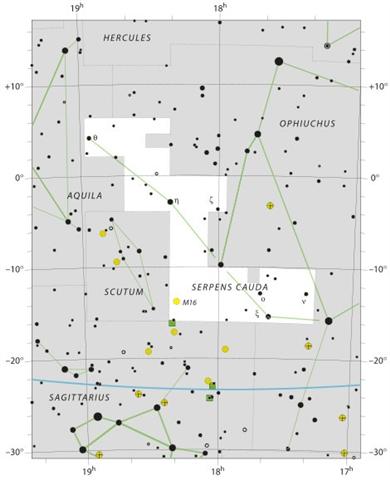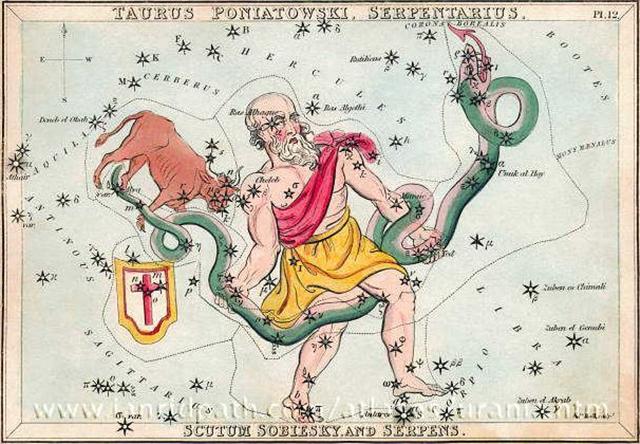1. The Tail of the Serpent
stretches for about a month and
rises up from Sabik
(η Ophiuchi), at the right leg of
Ophiuchus, to end with
θ:


|
Sabik |
17h 10m 22.66s |
17h 10.378m |
260.7 |
|
ν |
17h 20m 49.64s |
17h 20.827m |
263.4 |
|
ξ |
17h 37m 35.23s |
17h 37.587m |
267.6 |
|
ο |
17h 41m 24.92s |
17h 41.415m |
268.6 |
|
ζ |
18h 00m 28.92s |
18h 00.482m |
273.4 |
|
η |
18h 21m 18.92s |
18h 21.315m |
278.7 |
|
θ |
18h 56m 13.16s |
18h 56.219m |
287.5 |
|
18th hour: |
|
Sabik |
η Ophiuchi |
2.43 |
15° 40′ S |
17h 08m |
260.7 |
|
|
η Scorpii |
3.32 |
43° 14′ S |
17h 09m |
260.9 |
|
Nodus I |
ζ Draconis |
3.17 |
65° 47′ N |
17h 09m |
261.0 |
|
|
π Herculis |
3.16 |
36° 49′ N |
17h 12m |
261.7 |
|
Ras Algethi |
α Herculis |
3.31 |
14° 27′ N |
17h 12m |
261.8 |
|
Sarin |
δ Herculis |
3.12 |
24° 54′ N |
17h 13m |
262.0 |
| |
ο Ophiuchi |
5.14 |
24° 17′ S |
17h 15m |
262.4 |
| |
ξ Ophiuchi |
4.39 |
21° 07′ S |
17h 18m |
263.2 |
| |
θ Ophiuchi |
3.27 |
25° 00′ S |
17h
18m |
263.4 |
| |
ν Serpentis |
4.32 |
12° 51′ S |
|
|
ρ Herculis |
4.15 |
37° 09′ N |
17h 20m |
263.9 |
| |
σ Ophiuchi |
4.34 |
04° 08′ N |
17h 23m |
264.6 |
|
Lesath |
υ Scorpii |
2.70 |
37° 18′ S |
17h 28m |
265.7 |
|
Alwaid |
β Draconis |
2.79 |
52° 20′ N |
17h 29m |
266.1 |
|
Maasym |
λ Herculis |
4.41 |
26° 09′ N |
17h 29m |
266.1 |
|
Shaula |
λ Scorpii |
1.62 |
37° 04′ S |
17h 30m |
266.3 |
|
Kuma |
ν Draconis |
4.86 |
55° 13′ N |
17h 31m |
266.6 |
|
Ras Alhague |
α Ophiuchi |
2.08 |
12° 36′ N |
17h 33m |
267.1 |
|
Sargas |
θ Scorpii |
1.86 |
43° 00′ S |
17h 34m |
267.3 |
| |
μ Ophiuchi |
4.58 |
08° 07′ S |
17h 35m |
267.5 |
|
Nan Hae |
ξ Serpentis |
3.54 |
15° 24′ S |
17h
35m |
267.6 |
|
|
ι Herculis |
3.82 |
46° 00′ N |
17h 36m |
267.9 |
|
Girtab |
κ Scorpii |
2.39 |
39° 02′ S |
17h
39m |
268.6 |
| |
ο Serpentis |
4.24 |
12° 53′ S |
|
Kelb Alrai |
β Ophiuchi |
2.76 |
04° 35′ N |
17h 41m |
269.1 |
|
Kew Ho |
μ Herculis |
3.42 |
27° 43′ N |
17h 43m |
269.6 |
|
Apollyon |
ι Scorpii |
2.99 |
40° 08′ S |
17h 44m |
269.9 |
|
Muliphen |
γ Ophiuchi |
3.75 |
02° 42′ N |
17h 44m |
270.0 |
|
Basanismus |
G Scorpii |
3.19 |
37° 02′ S |
17h 46m |
270.5 |
|
Pherkard |
δ Ursae
Minoris |
4.35 |
86° 37′ N |
17h 48m |
270.9 |
|
Rukbalgethi
Genubi |
θ Herculis |
3.86 |
37° 15′ N |
17h 53m |
272.1 |
|
|
ξ Herculis |
3.70 |
29° 15′ N |
17h 54m |
272.5 |
|
Etamin |
γ Draconis |
2.24 |
51° 30′ N |
17h 55m |
272.7 |
|
|
ν Herculis |
4.41 |
30° 11′ N |
| |
ν Ophiuchi |
3.32 |
09° 46′ S |
17h 56m |
272.8 |
| |
ζ Serpentis |
4.62 |
03° 41′ S |
17h
58m |
273.4 |
|
19th hour: |
| |
τ Ophiuchi |
4.77 |
08° 11′ S |
18h 00m |
273.9 |
|
Zhōngshān |
ο Herculis |
3.84 |
28° 46′ N |
18h 04m |
275.0 |
|
Tung Hae |
η Serpentis |
3.23 |
02° 54′ S |
18h
19m |
278.7 |
|
Alya |
θ Serpentis |
4.62 |
04° 12′ N |
18h
53m |
287.5 |
 |
 |
 |
 |
|
Ga7-24
(194) |
Ga7-25 |
Ga7-26 |
Ga7-27
(*260) |
|
Cujam
(256.9) |
|
|
Sabik
(259.7),
η
Scorpii
(259.9),
Nodus I
(260.0) |
|
'December
3 (337) |
'4 |
17h
(258.7) |
'6 (340) |
|
"October
1 (274) |
"2 |
"3 |
"4 (277) |
 |
 |
 |
|
Ga7-28 |
Ga7-29 |
Ga7-30
(200) |
|
π
Herculis
(260.7),
Ras
Algethi
(260.8),
Sarin
(261.0),
ο
Ophiuchi
(261.4) |
ξ
Ophiuchi
(262.2),
θ
Ophiuchi,
ν Serpentis
(262.4) |
ρ
Herculis
(262.9) |
|
'7 |
'8 |
'9 |
|
"5 |
"6 |
"7 |
 |
 |
 |
 |
|
Ga7-31 |
Ga7-32 |
Ga7-33
(*266) |
Ga7-34
(204) |
|
σ
Ophiuchi
(263.6) |
Lesath-υ
(264.7),
Alwaid,
Maasym
(265.1),
Shaula
(265.3) |
Kuma
(265.6),
Ras
Alhague
(266.1),
Sargas
(266.3) |
μ
Ophiuchi
(266.5),
Nan Hae
(266.6),
ι
Herculis
(266.9) |
|
'December 10 |
'11 |
'12
(346) |
'13 |
|
"October
8 |
"9 |
"10 |
"11
(284) |
 |
 |
 |
 |
 |
 |
|
Ga8-1 |
Ga8-2 |
Ga8-3 |
Ga8-4
(*271) |
Ga8-5 |
Ga8-6 |
|
Girtab,
ο Serpentis
(267.6),
Kelb
Alrai
(268.1) |
Kew
Ho
(268.6),
Apollyon
(268.9),
Muliphen
(269.0) |
Basanismus
(269.5),
Pherkard
(269.9) |
Rukbalgethi
Genubi
(271.1) |
ξ
Herculis
(271.5),
ν
Herculis,
Etamin
(271.7),
ν
Ophiuchi
(271.8),
ζ Serpentis
(272.4) |
τ
Ophiuchi
(272.9) |
|
'14 |
'15 |
'16
(350) |
'17 |
'18 |
'19 |
|
"12 |
"13 |
"14 |
"15 |
"16 |
"17
(290) |
The Chinese
names Nan Hae
and Tung Hae
mean,
respectively,
the Southern Sea
and the heavenly
Eastern Sea,
according to
Allen.
The name Alya
has been touched
upon earlier:
... It [α]
was
also
Alioth,
Alyah,
and
Alyat,
often
considered
as terms for
the broad
and fat tail
of the
Eastern
sheep that
may have
been at some
early day
figured here
in the
Orientals'
sky; but we
know nothing
of this, and
these are
not Arabic
words, so
that their
origin in Al
Hayyah
[Arabic for
Snake] of
the
constellation
is more
probable ...
|









